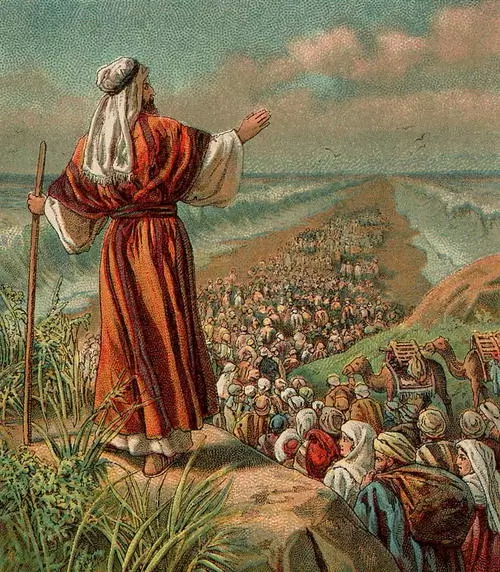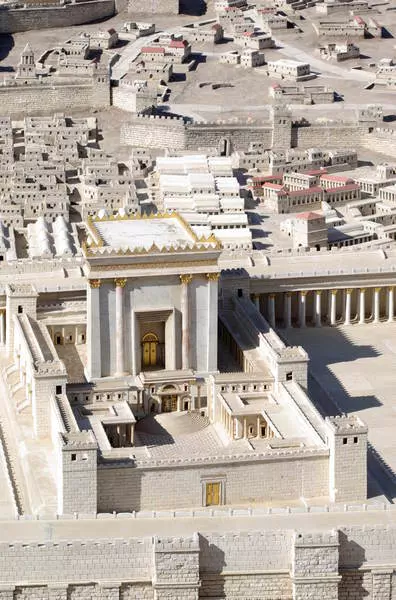Bible
The Gospels
The Bible takes its name from the Latin Biblia ('book' or 'books') which comes from the Greek Ta Biblia ('the books') traced to the Phoenician port city of Gebal, known as Byblos to the Greeks. Writing became associated with Byblos as an exporter of papyrus (used in writing) and the Greek name for papyrus was bublos.
Although the Bible is often considered a single, cohesive, work, it is actually an anthology of ancient writings by many different authors over many centuries, which were collected in a single book. The Bible contains works of poetry, religious-themed narratives, philosophical musings such as The Book of Ecclesiastes, epistles, and the apocalyptic masterpiece known as The Book of Revelation.
THE COMMON THREAD IN THESE COLLECTED WORKS IS THE EXISTENCE OF AN ALL-POWERFUL DEITY WHO IS THE CREATOR OF THE UNIVERSE & HAS AN INTEREST IN THE LIVES & FATE OF HUMANS.
The common thread in all these collected works is the existence of an all-powerful deity who is the creator of the universe and has an interest in the personal lives and final fate of human beings. The books of the Christian Bible were arranged in the sequence one finds them in today to tell the story of the creation of the world by a supreme deity, the fall of man from paradise, and humanity's redemption by the Son of God but these books were not written in that sequence nor would the original authors of the Old Testament works have had that particular story in mind.
The Bible of Judaism (collected and authorized by c. 3rd century BCE) contains the Torah (the first five books of the Bible) and the Tanakh (the stories of the judges and prophets) and makes no mention of Jesus Christ. The God of the Bible in these works is the God of Judaism - a single all-powerful deity - and, prior to the appropriation of Hebrew scriptures by early Christianity, the stories which made up the Bible told the story of God's care for and intervention in the affairs of the Israelites of the Middle East.
Structure of the Bible
In Judaism, the scriptures are called the Tanakh and are recognized as comprising 24 books divided into three categories: The Pentateuch (or Teachings of the Five Books of Moses), The Prophets, and The Writings. Christianity, which appropriated the Tanakh and claimed it as their own early theological history, call it the Old Testament. Early Christian writers, years after the probable date of the death of Jesus, penned the gospels and The Book of Acts. Paul the Apostle wrote most of the epistles which make up the 27 books of the Christian New Testament and whose theology informs the gospels. The Book of Revelation, attributed to John of Patmos, is the last book of the Christian Bible.
Moses & the Parting of the Red Sea
It is difficult to accurately date the composition of the books which make up the Bible, but scholars generally agree that the Pentateuch dates to the 10th and 6th centuries BCE and that the Tanakh was fixed as scripture well before the 1st century CE. The books of the Christian New Testament were composed between 60-110 CE (the Gospels), 45-130 CE (the Epistles), and 68-100 (The Book of the Revelation of St. John). Many people of the ancient world, and even today, believe the Bible to have been written by God. It is held to be the bestselling book in history and has influenced religious thought worldwide for centuries.
Brief Synopsis & Commentary
The book of Genesis, the first book of the Old Testament, tells the story of the creation of the universe, the world, and humanity, the fall of man in the Garden of Eden, and the great flood which God sent on the world because of the evil of mankind. Following the flood, Noah's children repopulate the earth and the narrative then follows the stories of his descendents who are the Hebrew ancestors of the men who wrote the stories. The tale of Joseph and his coat of many colors brings the Hebrews from their land of Canaan to Egypt where, the Book of Exodus explains, they became slaves.
They were led from Egypt to freedom by the great lawgiver Moses who then passed his leadership to his second-in-command Joshua son of Nun whose army lay waste to the region of Canaan so the Hebrews could claim it as the land promised to them by their God (as told in the Books of Joshua and Numbers). Following the establishment of the people who called themselves Israelites in the land, famous kings such as David and his son Solomon ruled and great prophets such as Jeremiah and Isaiah, Ezekial and Jonah preached the will of their God.
The New Testament focuses on the life and teaching of Jesus Christ, the son of God sent to redeem humanity from sin. Jesus is born of the virgin Mary and begins his ministry, preaching a direct and personal relationship with God, when he is about 30 years old. He is betrayed by one of his followers and crucified by the Romans for inciting sedition. Three days after his death, he rises from the grave and ascends to heaven to rule at the right hand of God the father. In his place, he sends the Holy Spirit who will henceforth minister to believers on earth. The New Testament ends with the vision of the end of the world as told by John of Patmos.
Jesus Christ Pantokrator
The first four books (Matthew, Mark, Luke, and John) are often believed to be eyewitness accounts of Jesus' ministry on earth but are not. The practice of writing under a famous person's name or, at least, attributing what one had written to someone better-known was well established at the time the gospels were written, and it is probable that the authors chose the names of people who were already well respected in the Christian community to gain a wider acceptance of the material.
There is also good reason to believe that the gospel narratives (both those included in the Bible and those which were rejected) are examples of a literary genre known as Mesopotamian Naru Literature in which some great historical figure (usually a king) is featured in an otherwise fictional tale. In the case of the gospels, it has been suggested, there may have been an historical figure such as Jesus of Nazareth who inspired stories and legends but the facts of that person's life are obscured by the genre they were written in which focuses on imparting an important cultural or spiritual truth, not relating history.
Because the gospels come before the Book of Acts and the Letters of Paul in the New Testament, many people seem to believe that these works were written first and the events they relate happened earlier than the later books; actually, the reverse is true. The letters of Paul came first and the gospels were written later. Paul's vision, in fact, informs all four of the gospels in the Bible and well as the Book of Acts.
THE STORIES IN THE BIBLE WERE CONSIDERED HISTORICALLY ACCURATE UNTIL ARCHAEOLOGISTS DISCOVERED THE CIVILIZATIONS OF MESOPOTAMIA & EGYPT.
Between 42-62 CE Paul the Apostle traveled throughout the Mediterranean on his evangelical missions preaching the new religion of the risen Christ. The Bible itself in the Book of Acts and I Peter allude to the possibility, explored in depth in the late 19th and early 20th century CE, that Paul's version of Christianity was different from the message preached by Jesus of Nazareth. Paul (formerly Saul) of Tarsus was a Jewish pharisee of Tarsus (in modern-day Syria) who claimed to have received a vision from God which convinced him of the reality of Jesus Christ as the risen son of the creator of the universe sent to earth to die for the sins of man.
While many people have since considered this a miraculous occurrence which displays God's love for humanity through the sacrifice of his son, the concept of the dying and reviving god figure was well known in Paul's time, and it is probable that beliefs such as the Cult of Isis informed the basis of Paul's religious views. The understanding of the Bible between the time of Constantine I's elevation of Christianity (which would become the religion of Rome in the 4th-5th centuries CE) and the next few hundred years was relatively unchanged until the Protestant Reformation of the 16th century CE but, in the 19th century CE, biblical interpretation underwent a radical reformation.
Biblical Understanding & 19th-century CE Archaeology
The stories which the Bible relates were considered to be historically accurate and entirely unique until the mid-19th century CE when archaeologists discovered the civilizations of Mesopotamia and Egypt. The Bible, in fact, was considered the oldest book in the world until much older literature was discovered which told the same stories, in an earlier form, than those found in the Bible. Scholars had long known that the Bible was a compilation which had been gathered from earlier works and authorized under the Bishops of Rome but no one seemed to be aware that those works were drawn from even earlier pieces. No one could read Egyptian hieroglyphics until Jean Jacques Champollion (1790-1832 CE) deciphered them and the literature of Sumer was completely unknown to the modern world.
Model of Herod's Renovation of the Temple of Jerusalem
Au milieu du XIXe siècle de notre ère, des musées et des publications ont envoyé des archéologues de l'ouest dans la région de la Mésopotamie pour trouver des preuves physiques qui étayeraient les récits bibliques. Le 19ème siècle de notre ère a été une période intéressante pour la religion en Occident, en particulier le christianisme, en ce sens que les gens sont devenus plus virulents dans leur critique de la foi et que de nouvelles idées et philosophies ont fourni des alternatives acceptables à la croyance religieuse. L'ouvrage de Charles Darwin sur l'origine des espèces au moyen de la sélection naturelle a été publié en 1859 de notre ère et a contesté la croyance traditionnelle en la création de l'humanité par un Dieu tout-puissant.
La Bible affirmait que Dieu avait fait l'homme "un peu inférieur aux anges" (Psaume 8: 5) tandis que Darwin affirmait que les humains avaient évolué à partir d'espèces inférieures. En 1882 de notre ère, le philosophe allemand Nietzsche a publié son ouvrage The Gay Science , qui disait " Dieu est mort - et nous l'avons tué ". La ligne de Nietzsche est presque toujours prise hors contexte comme une répudiation provocante de la religion mais, en fait, il disait seulement que les progrès de la technologie et des connaissances tout au long du 19ème siècle de notre ère avaient rendu le concept de Dieu obsolète. En partie en réponse à de telles affirmations, les musées et les sociétés à prédominance chrétienne de l'ouest ont envoyé ces équipes d'archéologues en Mésopotamie pour trouver des preuves tangibles de la véracité de la Bible.
Ce qu'ils ont trouvé à la place, c'est l'ancienne civilisation de la Mésopotamie et le riche patrimoine littéraire enfoui sous les sables pendant des siècles. Des histoires emblématiques telles que la chute de l'homme et le grand déluge, ont-ils découvert, n'étaient pas du tout uniques à la Bible, mais avaient déjà été écrites des siècles avant que les scribes hébreux ne les révisent dans leur propre travail. On a découvert que le grand code de loi de Moïse, considéré comme le premier de l'histoire, avait eu un prédécesseur dans le code de loi d'Ur-Nammu et le plus célèbre code d'Hammourabi .
Les fouilles en Égypte, quant à elles, n'ont trouvé aucune preuve de l'histoire de l'esclavage des Hébreux sous le pharaon d'Égypte , ni aucune des autres détails trouvés dans le Livre de l'Exode. Une fois que les hiéroglyphes égyptiens anciens ont pu être lus, les mythes de l'Égypte se sont avérés avoir des similitudes avec la figure chrétienne du dieu mourant et ressuscité et Marie, la mère de Jésus, ayant pris de nombreux attributs et épithètes de l'Égyptien. déesse Isis. Au fur et à mesure que les histoires de ces découvertes devenaient plus largement connues, la croyance en la Bible en tant que parole de Dieu a commencé à se transformer en une compréhension de l'œuvre inspirée par Dieu ou en tant qu'Écriture écrite par des hommes inspirés.
Conclusion
Bien que de nombreuses personnes à travers le monde continuent aujourd'hui à croire que la Bible est la parole de Dieu faisant autorité, cette croyance n'est pas aussi répandue qu'elle l'était avant le 19e siècle de notre ère. L'interprétation de la Bible de nos jours est en grande partie une question de compréhension individuelle sans les attentes de la société qui ont informé la société occidentale avant le travail des érudits, des archéologues et des historiens au 19e siècle de notre ère.
Ces individus ont changé le monde en révisant radicalement la compréhension des gens de l'histoire et de la Bible et en ouvrant des voies de recherche qui ont considérablement élargi les connaissances humaines. La compréhension révisée de la Bible et sa place dans l'histoire ont bouleversé de nombreuses personnes à l'époque et continuent de le faire de nos jours, mais, pour beaucoup d'autres, la beauté du langage de la Bible et la grande vision de la rédemption qu'elle présente ne sont pas diminuées par les révélations révisionnistes. du 19e siècle de notre ère. La Bible continue d'inspirer et d'encourager les gens du monde entier, traduite dans toutes les langues, et reste le livre le plus vendu de tous les temps.
Bibliography
Bauer, S. W. The History of the Ancient World. Peace Hill Press, 2006.
Darwin, C. The Origin of Species. Signet, 2003.
Helms, R. M. Who Wrote the Gospels?. Millenium Press, 1997.
Jonker, G. The Topography of Remembrance. Brill, 1995.
Kriwaczek, P. Babylon: Mesopotamia and the Birth of Civilization. St. Martin's Griffin, 2008.
Nietzsche, F. & Kaufmann, W. The Gay Science. Vintage, 1994.
Shaw, I. The Oxford History of Ancient Egypt. Oxford University Press, 2004.
Van De Mieroop, M. A History of the Ancient Near East ca. 3000 - 323 BC, 2nd Edition. Blackwell Publishing, 2006.
Various Ancient Authors. The Bible, King James Version. Thomas Nelson, 2000.
Wilkinson, R. H. The Complete Gods and Goddesses of Ancient Egypt. Thames & Hudson, 2007.
Translations
We want people all over the world to learn about history. Help us and translate this definition into another language! So far, we have translated it to: French, Spanish
About the Author
Joshua J. Mark
A freelance writer and former part-time Professor of Philosophy at Marist College, New York, Joshua J. Mark has lived in Greece and Germany and traveled through Egypt. He has taught history, writing, literature, and philosophy at the college level.
https://www.worldhistory.org/bible/





